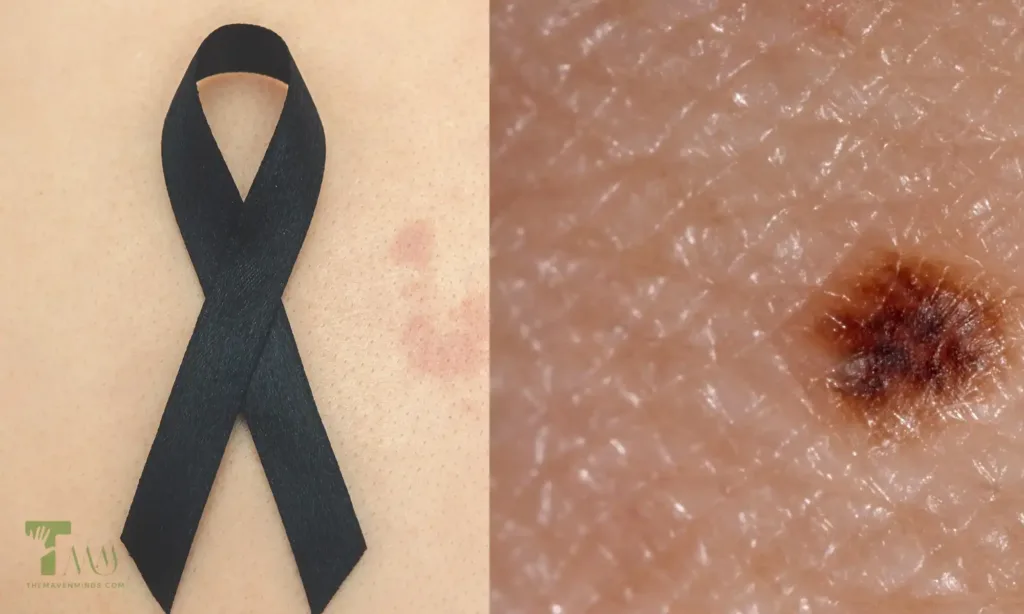Melanoma, a type of skin cancer, demands our immediate attention. In this comprehensive guide, we will delve into the details of melanoma, its causes, symptoms, and preventive measures. Our mission is to empower you with knowledge, so let’s dive right in!
What is Melanoma?
Melanoma is a malignant skin tumor that develops in melanocytes, the cells responsible for producing melanin. Melanin is the pigment that gives color to our skin, eyes, and hair . It commonly appears on sun-exposed areas such as the face, neck, arms, and legs, but it can also occur in unexpected places like the palms, soles of the feet, and under the nails.
Causes and Risk Factors
While researchers are still studying the exact cause of melanoma, several risk factors have been identified. Understanding these risk factors can help us take proactive steps to protect ourselves.
Ultraviolet (UV) Exposure: Overexposure to UV radiation from the sun or artificial sources like tanning beds increases the risk of developing melanoma. It’s crucial to be mindful of our sun exposure habits and take necessary precautions.
Fair Skin: Individuals with fair skin, light hair, and light-colored eyes are at a higher risk due to reduced natural protection against UV radiation. Our skin type plays a significant role in determining our vulnerability.
Family History: Having a family history of melanoma increases the risk. Genetic factors can make us more susceptible, but being aware can help us take preventive measures.
Moles: Having many moles or certain types of moles can raise the risk of melanoma. It’s important to be vigilant and monitor any changes in our skin, especially concerning moles.
Weakened Immune System: A compromised immune system, such as in organ transplant recipients or individuals with HIV/AIDS, increases susceptibility to melanoma. Taking care of our overall health is crucial in reducing the risk.
Recognizing the Symptoms
Early detection is key to successfully treating melanoma. By familiarizing ourselves with the warning signs, we can take prompt action and seek medical help when needed. Here are a few signs and symptoms to be mindful of :
Asymmetry: A mole or lesion that is asymmetric in shape, where one half does not match the other. Any unusual asymmetry should be examined.
Border Irregularity: Melanomas often have uneven or jagged borders, unlike benign moles with smooth edges. Pay attention to any irregularities.
Color Variation: Melanomas may exhibit different shades of brown, black, red, blue, or white within the same lesion. Unusual color patterns should be investigated.
Diameter: Melanomas are typically larger in diameter compared to common moles, usually exceeding 6 millimeters. Regularly check for any significant changes in size.
Evolution: Be mindful of any changes in the size, shape, color, or elevation of a mole, as well as new symptoms like itching or bleeding. Changes are worth investigating.
Preventive Measures
Prevention is key when it comes to reducing the risk of melanoma. By following these essential guidelines, we can protect our skin and prioritize our well-being:
Sun Protection: Limit sun exposure between 10 a.m. and 3 p.m., when the sun’s rays are strongest. Wear protective clothing, wide-brimmed hats, and sunglasses. Apply broad-spectrum sunscreen with an SPF of 30 or higher, reapplying every two hours or after swimming or sweating.
Avoid Tanning Beds: Tanning beds emit UV radiation that can be even more harmful than the sun itself. Choose safer options such as self-tanning products instead.
Regular Skin Examinations: Perform monthly self-examinations of your skin to detect any changes or new moles. Additionally, schedule annual skin screenings with a dermatologist. Early detection is key.
Protect Children: Educate children about sun safety from an early age. Encourage the use of sunscreen, protective clothing, and hats. By instilling healthy habits early on, we can protect their future well-being.
Seeking Medical Help
If you suspect a potential melanoma or notice any concerning changes in your skin, it’s important to consult a healthcare professional promptly. Timely detection significantly increases the likelihood of effective treatment. Your doctor may perform a thorough examination, recommend a biopsy, or refer you to a dermatologist or oncologist for further evaluation. Remember, timely action can make all the difference.
Conclusion
Melanoma is a serious condition, but with knowledge and proactive steps, we can significantly reduce our risk. This comprehensive guide has provided you with valuable information to understand melanoma, its symptoms, and preventive measures. Now, it’s up to you to prioritize your health. Stay vigilant, protect yourself from the sun’s harmful rays, and prioritize regular skin examinations. Remember, your well-being matters!
FAQs
- Can melanoma only occur on sun-exposed areas?
No, while melanoma commonly appears on areas exposed to the sun, it can also occur on non-sun-exposed areas like the palms, soles of the feet, and under the nails. - Are all moles a cause for concern?
Not all moles are indicative of melanoma. However, it’s essential to monitor any changes in moles, such as size, shape, color, or symptoms like itching or bleeding. - Is sunscreen alone enough to prevent melanoma?
Sunscreen is an essential part of sun protection, but it should be combined with other measures like wearing protective clothing, seeking shade, and avoiding tanning beds for comprehensive protection. - Can melanoma be completely cured?
With early detection and prompt treatment, melanoma can often be successfully treated. However, it’s crucial to prioritize preventive measures and regular skin examinations to catch any potential signs early. - How can I protect my children from melanoma?
Teach your children about sun safety, including the use of sunscreen, protective clothing, and hats. Instilling these habits early on can help protect their skin from harmful UV radiation.

